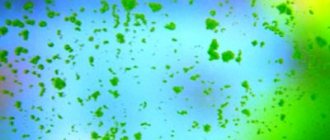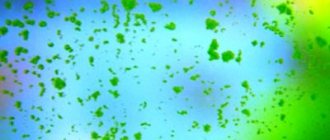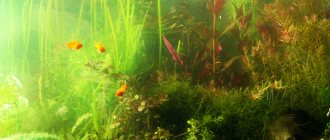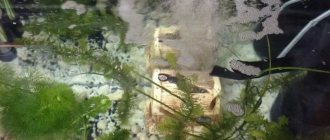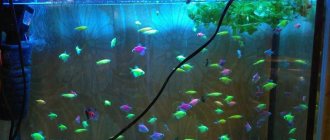Cloudiness of the water in an aquarium is a common event that terrifies novice fish keepers. When trying to purify water, beginners often make mistakes that lead to the liquid becoming more cloudy. In order not to aggravate the situation, you first need to figure out why the water in the aquarium is cloudy, and then begin to resolve the issue. Having figured out the cause of cloudy water in the aquarium, proven means and advice from experienced owners will help restore transparency.
Why did it become cloudy in the old and in the new, what is the difference?
Cloudiness in a new aquarium is normal and is due to the fact that the ecosystem has not yet stabilized.
It takes time for biological equilibrium to be established in it , when microorganisms are eaten by the inhabitants of the aquarium, and exactly as many bacteria are formed as necessary to maintain natural processes.
In an old aquarium, turbidity cannot appear just like that. And if this happens, it will not go away on its own until the cause is found out and measures are taken.
Nitrogen cycle
The fish in the aquarium deposit waste, and the feces sink to the bottom of the aquarium and begin to break down.
In this case, ammonia (NH3) is formed and deposited, which is bad because it is truly toxic. If enough ammonia builds up, it will begin to chemically burn the fish's gills and they will eventually die. Luckily, there are different types of good bacteria that colonize filters and help break down fish waste. One group of bacteria converts ammonia into nitrite (NO2-), and another group converts nitrite into nitrate (NO3-). Nitrates are much less toxic than ammonia and nitrite, so you can let them build up a little between water changes.
Ammonia and nitrite levels at 1 ppm can stress fish and lead to their death. In contrast, nitrates can be safely maintained at 40 ppm, but should ideally be maintained at 20 ppm.
What does the smell of a swamp mean?
There are 6 reasons why an aquarium may start to smell:
- Irregular care. For beginners, the signal for the need to clean is the unpleasant smell. The longer you wait to clean your aquarium, the nastier it will smell.
- Insufficient filtration (lack of oxygen).
- Incorrect selection of plants.
- The uncleaned body of a dead fish or snail.
- Overfeeding of the inhabitants (excessive amounts of feces or fish disease due to overeating).
- A large number of "residents". Feces do not have time to decompose, forming a concentrated, foul-smelling mass.
Removing the swamp smell is simple: wash the aquarium and change the water. But if you don’t find out the reason, the next wash is coming in a week.
How to prevent cloudiness
To prevent the water from acquiring unpleasant shades, you should follow the basic rules for maintaining aquariums and their inhabitants at home:
- Before launching, it is necessary to wash the glass and bottom substrate and disinfect the decorations;
- do not skimp on filters, do not neglect the standards for purifying water;
- Clean all new decorative elements thoroughly before immersing them in the container;
- constantly monitor the condition of the soil and replace it as it gets dirty;
- do not overfeed the inhabitants;
- promptly remove dead plants and animals.
How to deal with cloudiness?
To instantly remove turbidity, you can use special products:
Chemical. For example, aquarium water conditioners Crystal Water Tetra Aqua, Sera Aquaria Clear, Formamed, AquaCons.
They really help clear water from turbidity, making it crystal clear.- Folk. Some people prefer to add activated carbon to the filter. It not only retains particles of dirt, but also disinfects the water. Another option: place foam sponges or microfiber cloths in the filter.
These remedies do not fight the cause of the appearance of turbidity, but only temporarily eliminate it. You cannot use chemicals all the time, so you need to find out the cause of the cloudiness.
What to do if the water in the aquarium is cloudy
After analyzing the causes, you can proceed to measures to eliminate them for the normal functioning of the aquarium ecosystem:
- If the cloudiness is associated with overfeeding, then the fish are given a three-day diet, and in the future it is recommended to replace the powdered food with worms and insect larvae, which are sold in pet stores. If it is not possible to switch to natural ingredients, then bottom fish should be placed in the reservoir, which, by feeding on particles that have settled down, will improve the condition of the water.
- Rotten, damaged and film-covered algae are removed, the walls and soil are washed. Siphons are used to clean sand, and special carbon filters are used to clean water. Sidex is used to combat excessive algae growth.
- If there is overcrowding, the fish should be resettled.
- Many novice aquarists, when the water becomes cloudy, try to immediately get rid of the liquid, but this should never be done. Ichthyologists recommend replacing up to 15% of the volume of old water with new water once every two to three weeks or weekly. In this case, the added portion must be settled and at the same temperature as the aquarium water.
- To prevent algae from blooming, you should protect the tank from direct and prolonged lighting.
- Active saturation with oxygen is used as one of the methods for purifying liquid. In this case, it is necessary to avoid the appearance of bubbles on the walls, decorations and algae.
- If none of the above measures give the desired result, special coagulants and biological filters are used, inside of which there are two types of beneficial microorganisms that reduce the content of nitrates, nitrites and phosphates in the aquarium liquid.
- A natural cleanser is the aquatic plant Elodea serrata. It is unpretentious, does not produce much oxygen and at the same time can serve as green food for fish.
- Pet stores sell special conditioners designed to inhibit the growth of algae and neutralize waste products of harmful microorganisms and discolor liquids.
- The drug Bicillin-5, sold in pharmacies, can also be used to combat the resulting clouding. Before the medicine is poured into the container, all inhabitants are moved to another tank. And the drug is added to contaminated water for three days without interruption. If this period is not enough, then cleaning is continued for another week.
What to do for prevention?
Preventive measures to maintain aquarium cleanliness include following the basic rules for keeping fish.
You must first read the literature, and then choose the inhabitants and high-quality food for them , which should be poured with a measuring spoon at a specially designated time. It is also necessary to change the water on time and monitor the number of individuals in order to remove the corpses in a timely manner.
Sometimes the water becomes cloudy for particularly responsible owners. Therefore, you should not take the decorations out of the aquarium again to wash them.
There is no need to introduce an extra day of cleaning and scrape off the plaque that has just formed from the walls. It is not necessary to use the soil cleaner every day. Because turbidity in water is not only harmful, but also beneficial bacteria necessary to maintain the ecosystem.
Biological water treatment
Biological water purification includes the most important processes occurring in closed aquarium systems. By biological purification we mean the mineralization, nitrification and dissimilation of nitrogen-containing compounds by bacteria living in the water column, gravel and filter detritus.
Organisms that perform these functions are always present in the depth of the filter. During the process of mineralization and nitrification, nitrogen-containing substances change from one form to another, but the nitrogen remains in the water. Removal of nitrogen from solution occurs only during the process of denitrification (see section 1.3). Biological filtration is one of four ways to purify water in aquariums. Three other methods - mechanical filtration, physical adsorption and water disinfection - are discussed below.
The water purification scheme is shown in Fig. 1.1., and the nitrogen cycle in the aquarium, including the processes of mineralization, nitrification and denitrification, is shown in Fig. 1.2.
Rice. 1.1. Place of biological treatment in the water purification process. From left to right – biological sedum, mechanical filtration, physical sedimentation, disinfection.
Rice. 1.2. Nitrogen cycle in aquarium closed systems.
1.1. Mineralization.
Heterotrophic and autotrophic bacteria are the main groups of microorganisms that live in aquariums.
Note not from the author's book.
Heterotrophs (ancient Greek - “different”, “different” and “food”) are organisms that are not capable of synthesizing organic substances from inorganic ones by photosynthesis or chemosynthesis. To synthesize the organic substances necessary for their life, they require exogenous organic substances, that is, produced by other organisms. During the digestion process, digestive enzymes break down polymers of organic substances into monomers. In communities, heterotrophs are consumers of various orders and decomposers. Almost all animals and some plants are heterotrophs. According to the method of obtaining food, they are divided into two contrasting groups: holozoans (animals) and holophytes or osmotrophs (bacteria, many protists, fungi, plants).
Autotrophs (ancient Greek - self + food) are organisms that synthesize organic substances from inorganic ones. Autotrophs make up the first tier in the food pyramid (the first links of food chains). They are the primary producers of organic matter in the biosphere, providing food for heterotrophs. It should be noted that sometimes it is not possible to draw a sharp boundary between autotrophs and heterotrophs. For example, the unicellular alga Euglena green is an autotroph in the light, and a heterotroph in the dark.
Sometimes the concepts of “autotrophs” and “producers”, as well as “heterotrophs” and “consumers” are mistakenly identified, but they do not always coincide. For example, blue-greens (Cyanea) are capable of producing organic matter themselves using photosynthesis, and consuming it in finished form, and decomposing it into inorganic substances. Therefore, they are producers and decomposers at the same time.
Autotrophic organisms use inorganic substances from soil, water and air to build their bodies. In this case, carbon dioxide is almost always the source of carbon. At the same time, some of them (phototrophs) receive the necessary energy from the Sun, others (chemotrophs) - from chemical reactions of inorganic compounds.
Heterotrophic species utilize organic nitrogen-containing components of aquatic animal excretions as an energy source and convert them into simple compounds such as ammonium (the term "ammonium" refers to the sum of ammonium ions (NH4+) and free ammonia (NH3), determined analytically as NH4-N ). Mineralization of these organic substances is the first stage of biological treatment.
Mineralization of nitrogen-containing organic compounds can begin with the breakdown of proteins and nucleic acids and the formation of amino acids and organic nitrogenous bases. Deamination is a mineralization process during which an amino group is eliminated to form ammonium. The subject of deamination can be the splitting of urea with the formation of free ammonia (NH3).
Such a reaction can proceed purely chemically, but the deamination of amino acids and their accompanying compounds requires the participation of bacteria.
Why does the aquarium stink?
There may be several reasons why an aquarium stinks. Let's try to determine the source of the smell.
- The source of the odor may simply be the cover glass or aquarium lid. Let's start with this. Quite often they forget to wash them when replacing them. Due to moisture and light, algae and colonies of bacteria can grow there, which, if successfully maintained, stink. There may also be an accumulation of food on the glass or lid that did not get into the aquarium. The food rots and can also be a source of stench.
- Reason number two. Dead fish in an aquarium. This is all clear.
- The water may smell like a swamp if it is blooming. Typically, this can be due to too much light or because the aquarium is in direct sunlight.
- Another reason may be rare soil siphonage. If you do not touch the soil, fish waste begins to decompose there, which forms hydrogen sulfide. This is why the water in the aquarium smells rotten.
- Decor or soil may smell if it has not been properly treated before placing it in the aquarium.
Ways to eliminate turbidity
You can get rid of cloudy water in different ways:
- It is necessary to clean the aquarium of waste products mechanically and replace a quarter of the water volume. It is convenient to clean the soil using a special device - a siphon. Sometimes it becomes necessary to completely remove the soil and wash it under running water.
- Disperse aquatic inhabitants if their number exceeds the norm for a given tank volume. It is necessary to take into account the number of not only fish, but also shellfish.
- If you reduce the light load by moving the aquarium to a darker place, you can slow down the proliferation of microscopic algae. The same effect can be achieved by changing the lamp to a less powerful one or raising it higher.
- Sometimes it is enough to choose a more powerful filter or simply clean the filter element.
- If after 5-10 minutes, after the food was poured, it was not eaten, reduce the portion.
- Intensive aeration of water helps restore water balance. It is necessary to take into account what kind of fish are inhabited. Not everyone can tolerate the movement of water. Aeration is more a method of prevention.
- You can quickly and effectively clean an aquarium from mechanical turbidity using chemicals.
In advanced cases, when substances hazardous to fish have entered the water, or decorative items have reacted with the aquatic environment, it must be completely changed.
Attention! The choice of method to eliminate the problem depends on the cause that provoked this condition.
Why did the water become cloudy on the second day?
This problem most often occurs when the aquarium is too small and there are many fish in it or they are too large for it. Most often, in such cases, noticing a bad situation in the reservoir, the owners do not drain all the liquid, but only a small part of it.
Thus, after such a substitution, on the second day the situation will repeat again. This can only be avoided when the water drains all the way to the ground. Only after this can the fish be released. This must be done regularly to prevent mass reproduction of harmful organisms.
Consequences for fish
When the balance of an ecosystem is disturbed, the environment changes for the worse. The water becomes cloudy, and a barely noticeable smell can turn into an unbearable stench.
Such changes have adverse consequences for the inhabitants of the aquarium:
- loss of appetite of fish;
- decreased vitality of pets;
- damage to plants;
- emergence and spread of infectious diseases;
- changes in the bacterial composition of water;
- death of fish and other animals.
When is this a problem, and when is it not worth worrying about?
The turbidity itself does not pose any danger to the biological system of the aquarium and to plants. But the nitrogen cycle in such an aquarium has not yet started, so there will be a large amount of ammonium/ammonia in the water, and then nitrite, which have a poisonous effect on the fish.
This is why experienced aquarists do not recommend placing fish in a newly launched aquarium. It will take several weeks before the aquarium “cycles” and the water becomes suitable for the inhabitants.
You should only worry if the owner, due to inexperience, released fish or shrimp into a barely started aquarium. This is a huge threat to their lives.
No matter how sellers in pet stores or manufacturers of biostarters (bacterial additives for aquariums) claim, the nitrogen cycle starts completely within a month , so it is absolutely forbidden to introduce fish in the first days. Especially the delicate and demanding species.
